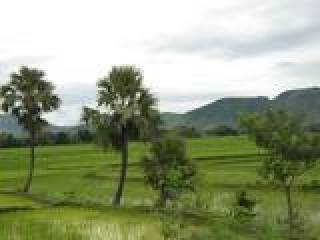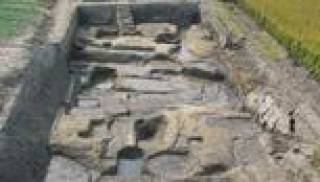In the Spring of 2008, many will have seen headlines about a "rice shortage" in Asia. Much of Asia depends on rice as a staple food, and so it has been for some 1000s of years.
As most will know rice is a regular component of the cuisines of India, China and Southeast Asia, and it has been since the very beginnings of farming. East Asia, Southeast Asia and the Indian subcontinent boast the world's highest population densities, and this is possible in large measure because of rice, which in the appropriately irrigated fields is by far the world's most productive grain.

While rice has featured in the agriculture of South and East Asia since prehistoric times, recent archaeological research has offered new insights and raised new questions about when, how and why rice first came to be cultivated.
The highly productive rice crops of today are domesticated plants, which differ in morphology and genetics from wild rice by possessing adaptations that make them productive in cultivation but also dependent on cultivation for survival.
Improved methods of archaeobotany are providing new insights into how domesticated rice evolved. There is increasing recognition that we need to, and can, distinguish the beginnings of "cultivation" when human behaviours changed, and "domestication", when the plant itself subsequently changed to become a better crop. In addition, genetic research is offering additional information. For an up to date summary of archaeobotanical approaches to rice, download Rice: A users manual for archaeologists (Jan. 2018).

There are potentially many different forms of rice cultivation, including artificial wetlands (paddy-fields), cultivation on natural monsoon rains and river inundation and even inclusion of rice in slash-and-burn agriculture of some tropical mountain regions.
Which of these systems of cultivation came first is a question that is becoming answerable, and is a major research aim of the Early Rice Project.
Our conclusions so far are presented in the open access article "Pathways of Rice Diversification across Asia" (Dec. 2016)
with earlier results summarized in "The Early Rice Project: From Domestication to Global Warming" (Dec. 2011).
For more detailed academic results see these articles:
- Stevens, Chris J. and Dorian Q Fuller (2017) The Spread of Agriculture in Eastern Asia: archaeological bases for hypothetical farmer/language dispersals. Language Dynamics and Change 7: 152-186
- Murphy, Charlene A and Fuller, Dorian Q (2017) The Agriculture of Early India. In Oxford Research Encyclopedia of Environmental Science (H. Shugart ed.). Oxford University Press.
- Choi, Jae Young, Adrian E. Platts, Dorian Q Fuller, Yue-le Hsing, Rod A. Wing, and Michael D. Purugganan (2017) The rice paradox: Multiple origins but single domestication in Asian rice. Molecular Biology and Evolution 34 (4): 969-979.
- Yang, X., Zhuang, Y., Wang, W., Li, Z., Ma, Z., Ma, Y., Cui, Y., Wei, J. and Fuller, D.Q., (2016). New radiocarbon evidence on early rice consumption and farming in South China. The Holocene,
- Fuller, Dorian Q., Cristina Cobo Castillo, Charlene Murphy (2016) How rice failed to unify Asia: globalization and regionalism of early farming traditions in the Monsoon World. In: Tamar Hodos (ed.) The Routledge Handbook of Archaeology and Globalization. New York: Routledge, pp. 711-729
- Castillo, Cristina Cobo, Berenice Bellina, Dorian Q Fuller (2016) Rice, beans and trade crops on the early maritime Silk Route in Southeast Asia. Antiquity 90 (353): 1255-1269
- Stevens CJ, Murphy C, Roberts R, Lucas L, Silva F, Fuller DQ. (2016) Between China and South Asia: A Middle Asian corridor of crop dispersal and agricultural innovation in the Bronze Age. The Holocene 26(10): 1541-1555.
- Ruddiman, W. F., D. Q. Fuller, J. E. Kutzbach, P. C. Tzedakis, J. O. Kaplan, E. C. Ellis, S. J. Vavrus, C. N. Roberts, R. Fyfe, F. He, C. Lemmen, J. Woodbridge (2016). Late Holocene Climate: Natural or Anthropogenic? Reviews in Geophysics 54(1): 93-118 [online]
- Fuller, D. Q. and C. Castillo (2016) Diversification and cultural construction of a crop: the case glutinous rice and waxy cereals in the food cultures of eastern Asia. In: J. Lee-Thorp and M. A. Katzenberg (eds) The Oxford Handbook of the Archaeology of Diet. Oxford University Press [online]
- Weisskopf, Alison; Deng, Zhenhua; Qin, Ling; Fuller, Dorian Q (2015) The interplay of millet and rice in Neolithic central China: Integrating phytoliths into the archaeobotany of Baligang. Archaeological Research in Asia 4: 36-45 [online]
- Weisskopf, Alison; Qin, Ling; Ding, Jinglong; Ding, Ping; Sun, Guoping; Fuller, Dorian Q (2015) Phytoliths and rice: from wet to dry and back again in the Neolithic Lower Yangtze. Antiquity 89 (347): 1051-1063 [online]
- Deng, Zhenhua; Qin, Ling; Gao, Yu; Weisskopf, Alison R; Zhang, Chi; Fuller, Dorian Q (2015) From Early Domesticated Rice of the Middle Yangtze Basin to Millet, Rice and Wheat Agriculture: Archaeobotanical Macro-Remains from Baligang, Nanyang Basin, Central China (6700-500 BC) PLoS ONE (10) 10: e0139885 [online]
- Silva, Fabio; Stevens, Chris J; Weisskopf, Alison; Castillo, Cristina; Qin, Ling; Bevan, Andrew; Fuller, Dorian Q (2015) Modelling the geographical origin of rice cultivation in Asia using the Rice Archaeological Database. PloS one 10 (9): e0137024 [online]
- Fuller, Dorian Q, Yo-Ichiro Sato, Cristina Castillo, Ling Qin, Alison R. Weisskopf, Eleanor J. Kingwell-Banham, Jixiang Song, Sung-Mo Ahn and Jacob van Etten (2010). Consilience of genetics and archaeobotany in the entangled history of rice (2010). Archaeological and Anthropological Sciences 2 (2): 115-131 [online]
- Fuller, D. Q. and Ling Qin (2010) Declining oaks, increasing artistry, and cultivating rice: the environmental and social context of the emergence of farming in the Lower Yangtze Region.Environmental Archaeology 15 (2): 139-159 [online]
- FULLER, DQ, van Etten, J., Manning, K., Castillo, C., Kingwell-Banham, E., Weisskopf, A., Qin, L., Sato, Y., Hijmans, R. (2011). The contribution of rice agriculture and livestock pastoralism to prehistoric methane levels An archaeological assessment. The Holocene 21, 743-759 [online]
- FULLER, DQ (2012) Pathways to Asian Civilizations: Tracing the Origins and Spread of Rice and Rice Cultures. Rice 4: 78-92 [online]
if you can not access these you may contact the author for a copy.
 Close
Close

